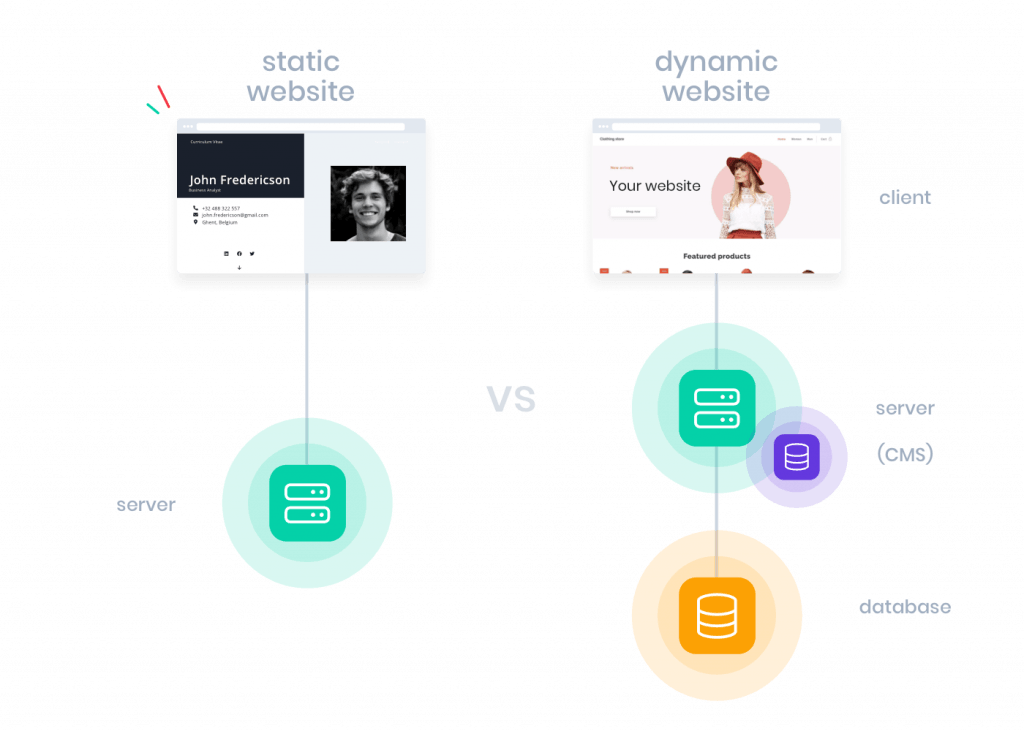What’s the difference between a dynamic website and a static website?

Creating your own website? Then you'd better be familiar with the difference between dynamic websites and static websites. One can compare it to the hairdresser you've been faithful to for years. Some like to do "something" different with your haircut once in a while, while others let you go home with your familiar, unchanged haircut.
What is a dynamic website?
In the online world, dynamic websites are the creative hairdressers. 😉 Because this type of website adapts to your needs or what you have requested. There's a reason why a dynamic website is an interactive and flexible website.
When you surf to a dynamic site, your web browser sends a request to the server of the website in question. To process that request in real time, the server uses server software (such as PHP, Python and JavaScript). The server can retrieve dynamic data from various locations. Think of preference settings, login information ... This whole technical process is called server-side scripts.
This gives internet users a personalized user experience. It is therefore no surprise that webshops, among others, come under the category of dynamic sites. After all, your shopping cart that is still filled even after you leave the site is dynamic content.
Tip
TipAre you thinking about starting your own webshop? Well, in that case, Combell is also the right place for you! With our Managed WordPress package, you can easily and quickly build your own web store.
Benefits of dynamic websites
Easy to manage
If you want to edit the content of a dynamic website, you don't have to dive into the code yourself. No, for that you use a Content Management System (CMS). CMS's are tools that allow you to use your website on a daily basis. As a restaurant owner, updating your menus, putting a new blog post online ... That's what you do through your CMS.
When it comes to CMS's, WordPress is the obvious choice. It's a very popular Content Management System. About 40% of all websites run on WordPress. Even our Combell Blog, the site you are visiting right now, is a WordPress website.
Moreover, using a CMS such as WordPress, you can easily collaborate with each other. You can register different users and create content together. So, you do not have to do everything on your own.

Further on our website, you will discover which WordPress packages Combell has to offer you. Whether you think big or rather modest... You will certainly find a package that suits your project. Of course, there are other systems such as Drupal and Joomla. That is why we have already made the comparison for you. 🙂
Also read
Use this ultimate starter guide to create your own WordPress website.
Personal and interactive
One of the benefits of a dynamic website is the personalized user experience your customers are looking for. Customized promos, exclusive offers ... You have a lot of customization options. This in turn increases the interaction on your site. For example: new leads who subscribe to your newsletter, an enthusiastic reader who shares your article on social media ...
Rank higher in Google
Thanks to dynamic websites, you have a better ranking in search engines. This is due to search engine optimization (SEO). For example, a CMS like WordPress has several features and tools to improve SEO, and you can also get better at it yourself by putting blogs and (new) pages online. A dynamic page where new content comes online regularly will be picked up faster by Google.
More scalability and flexibility
A dynamic website is scalable and can be easily expanded as your business or project grows. For that, you can count on the capabilities of your Content Management System, server software and your hosting provider.
Tip
Hosting your website with local provider? Don't underestimate the importance!
Disadvantages of dynamic websites
Updates and maintenance
With these types of websites, sometimes you need to get under the hood. Because your CMS and servers need updates and maintenance. Something you may not have any experience with at all yourself. Logical, you simply can't do everything. You can smartly address this minor downside by leaving your hosting entirely to your hosting partner. That's called managed hosting. You focus on the content of your WordPress website, we take care of maintenance and updates.
Loading speed
A dynamic website has a lot to offer. But then it needs the right support. Because if your server is overloaded or there are a lot of visitors surfing to your site at the same time, it can cause a too slow loading speed. Which is actually as bad as a site being offline. Therefore, choose the right hosting package for your website.

Security risks
Since dynamic Web sites use scripting language (server-side scripts) and a database, they can be more susceptible to security problems, such as SQL injections and cross-site scripting (XSS) attacks.
Therefore, choose a hosting company that is constantly alert to security risks and regularly applies updates and patches to protect your website. No need to panic: here at Combell, we constantly work on cyber security. Because a good site is a secure site. 😉
Dynamic website examples
What is a static website?
Over to the barber who always puts your hairstyle in the right, but same fold. A true professional, but not a fan of big changes. 😀
Static websites are generally very simple websites. They usually operate without a CMS and the content is created right away via HTML code and HTML files. Each file is immediately displayed on the website. The content and layout are not set in stone.
As a website owner, it is not easy to modify the content of a static page. And as an Internet visitor, your user experience is much less personal. After all, all content is the same for everyone. In return, you do get a simple site that will load quickly and is easy to maintain yourself.

Benefits of static websites
Fast loading speed
A static website basically loads faster. Not entirely illogical when you know that such websites are very simply built and usually receive a limited number of visitors across your digital floor. Another additional advantage: a static website has direct source code that can be easily displayed to the visitor from the web server. This makes loading the content fast without delays or technical problems.
Affordable hosting
Hosting a static website is cheaper. That's because a static website does not require a database and requires less server processing power to load, the cost of hosting is usually lower than that of a dynamic website.
Inexpensive website
A static website is more cost-effective to build. Thanks to the limited complexity, you can quickly build and launch your own static website, which reduces the (construction) costs. By the way, Combell SiteBuilder is an excellent platform to build a static website easily and budget-friendly. Useful if you are not familiar with HTLM code.
Easy to maintain
A static website does not have high maintenance costs. Since no Content Management System (CMS) is installed, you don't have to maintain or update it either. Moreover, you don't have to take as stringent security measures.
Disadvantages of static websites
Limited scalability
A static website has limited scaling capability as all pages must be built and managed separately. This makes managing static websites with a lot of content more difficult. Thus, it is mostly smaller websites that are built as static sites.

Difficult to manage
You may launch it quickly, but afterwards it is not easy to manage your site. That's because you always have to have all changes made by someone with HTML knowledge. If you can't write HTML code yourself, you can't make changes to your Web site. If you only do a few changes a year, you may be able to go to your Web site builder. But if you want to make weekly changes, the cost can add up very quickly.
Static website examples
Static website vs dynamic website: similarities
Anyone who has been paying close attention already knows the areas in which dynamic and static sites differ. The pros and cons make one thing and another clear. But where are the main similarities? Because after all, a static and dynamic website are both a type of website.
Well, both types of websites use the same basic format. Although dynamic websites require knowledge of "server and programming code," both static and dynamic sites rely on HTML and CSS for their front-end.
Both responsive
Both static and dynamic websites can contain large amounts of content, such as text, images and videos. They can also both be responsive, meaning that the layout of the content automatically adapts to the device being used. Although you might initially think of this as a "dynamic" feature, a static web site can just as easily be responsive, depending on the HTML and CSS code used.

Although you need some programming knowledge to build both types of websites from scratch, there are all kinds of solutions that make it much easier and avoid time-consuming programming. For example, you can build dynamic Web sites with existing tools such as SiteBuilder or WordPress. Static sites can also be created with a CMS, or you can use a static website generator. The latter tool is slightly less complicated than CSS and JavaScript files.
Create dynamic website? Or a static site anyway?
Over to the order of the day: building your own website. Want to keep your own site small and know something about HTML? Then you might consider starting with a static site. Do you see it a little bigger and also want to do a lot yourself without using code? Then you'll end up with a dynamic site either way.
Make no mistake: you can also create a modest, dynamic site. WordPress and SiteBuilder have plenty of options. If you get stuck, you can count on Combell's free support day and night.


